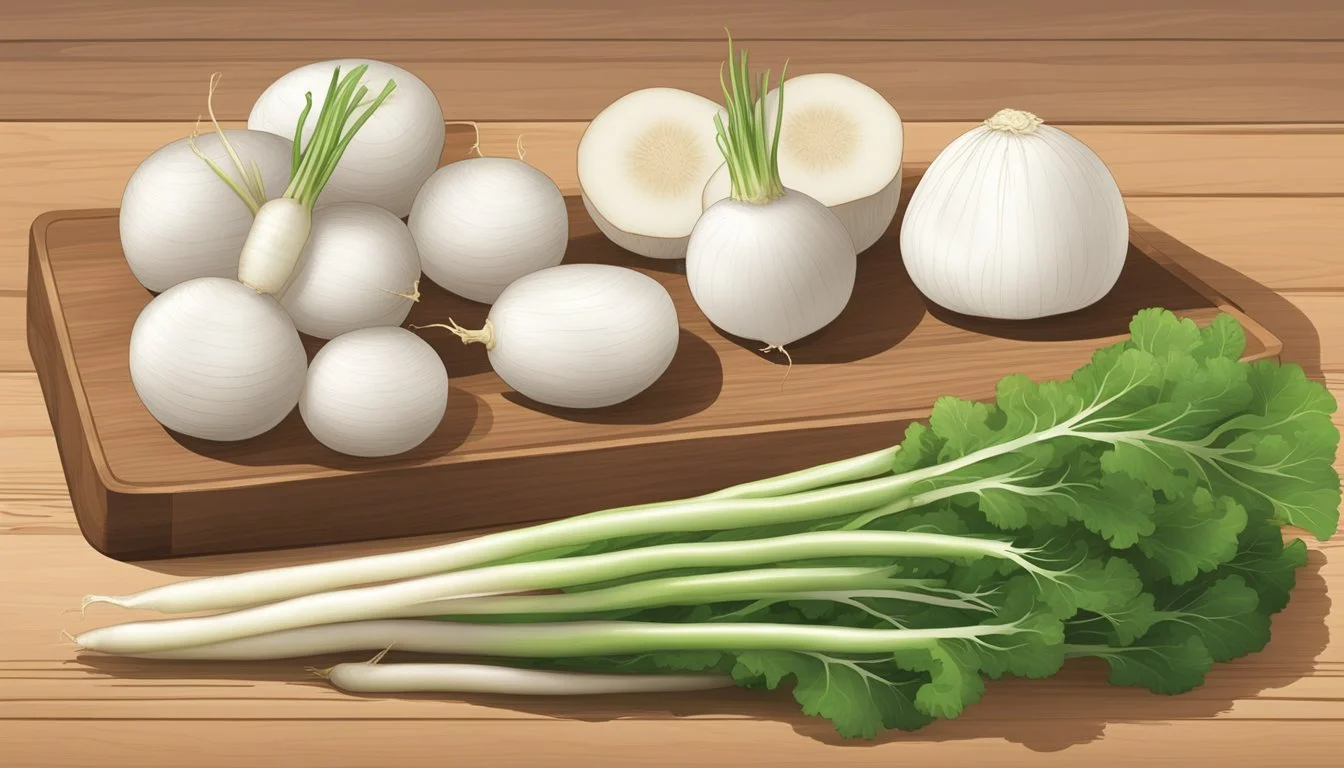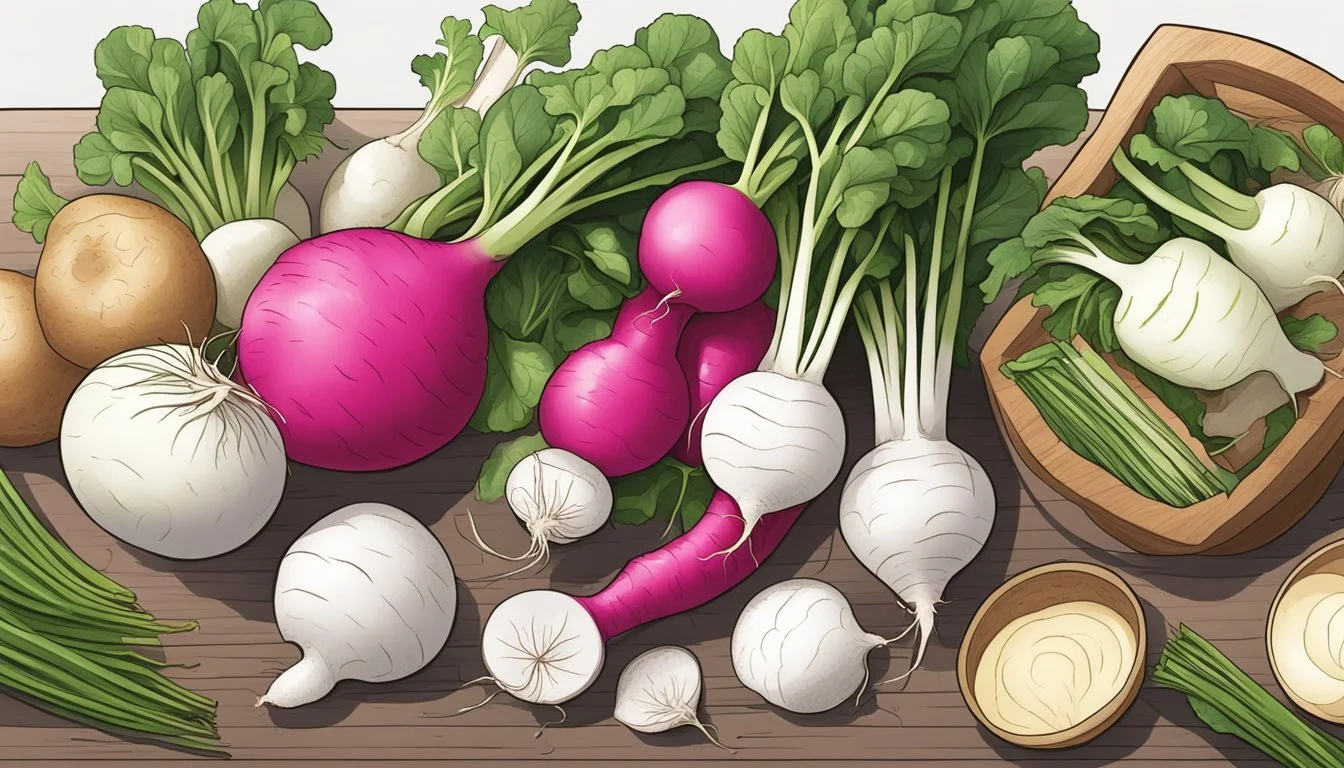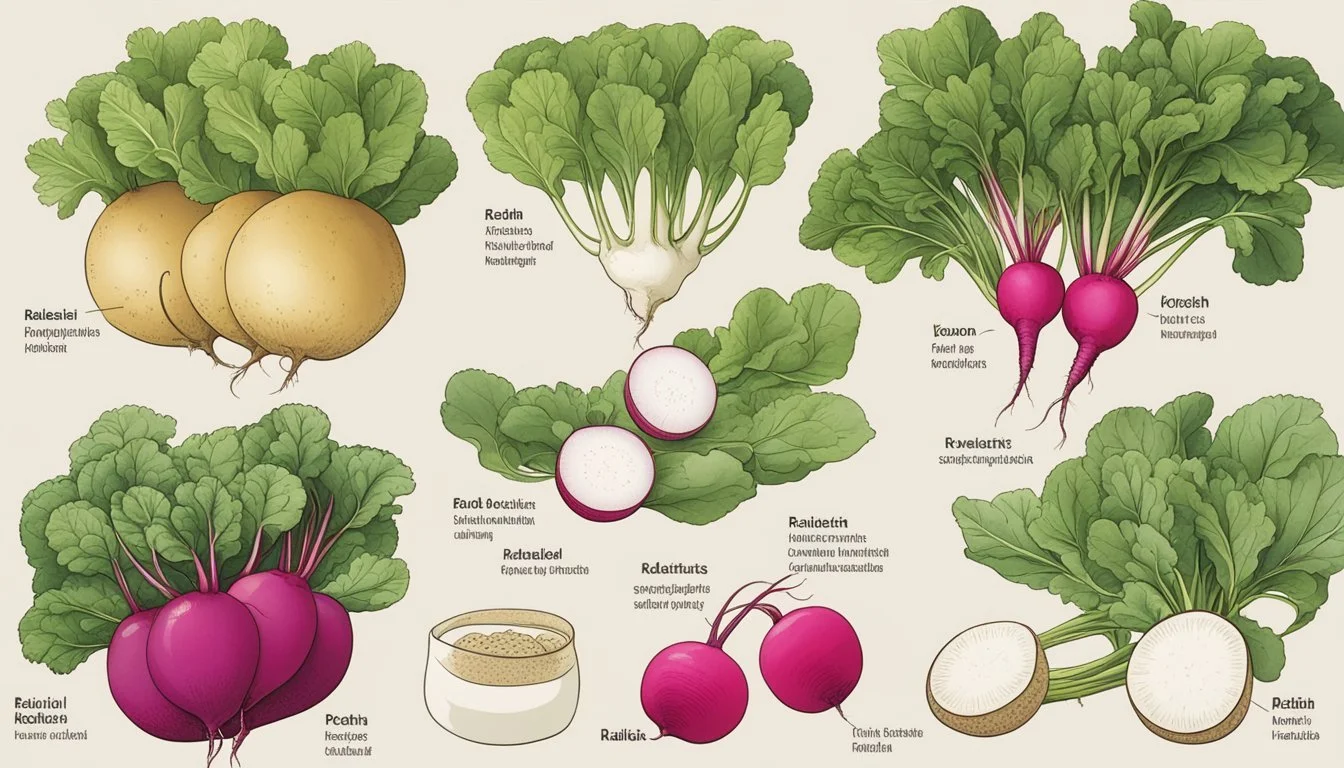Korean Radish Substitutes
Top Alternatives for Authentic Flavors
Korean radish is a staple in many Asian dishes, known for its crisp texture and mild, slightly sweet flavor. When a recipe calls for Korean radish, it's essential to find an appropriate substitute that can mimic these characteristics. One of the best substitutes for Korean radish is daikon, which shares a similar texture and flavor profile, making it an excellent choice for soups, stews, and kimchi.
Other great substitutes include red radish and watermelon radish. While they slightly differ in flavor, they offer the same firm texture and nutrient benefits. Additionally, firm white vegetables such as cauliflower or broccoli can be used in soups and stews, providing an interesting twist to traditional recipes that call for Korean radish.
Each of these substitutes brings its own unique qualities to the dish, though daikon remains the closest match to Korean radish. Experimenting with these various substitutes can lead to delightful culinary discoveries, ensuring that the absence of Korean radish doesn't impede the creation of delicious and authentic meals.
Understanding Korean Radish
Korean radish, also known as "mu" in Korean, is notable for its crunchy texture, mild flavor, and versatility in various culinary applications. This section explores its key characteristics, common uses in Korean cuisine, and its nutritional profile and health benefits.
Characteristics of Korean Radish
Korean radish has a distinct crunchy texture and a mild, sweet flavor. It is larger and rounder compared to other radishes like the daikon. The skin is often greenish at the top and white towards the bottom, with firm, white flesh inside. Native to Korea, this radish is an essential component in many traditional dishes due to its unique texture and subtle taste.
Culinary Uses in Korean Cuisine
Korean radish is a staple in many Korean dishes, appreciated for its crunchiness and subtle sweetness. It features prominently in kimchi, a fermented dish that showcases its ability to hold up in pickling. Additionally, it is used in soups and jjigae (stews) like Doenjang Jjigae and Kimchi Jjigae, adding texture and absorbing flavors from the broth. Salads also benefit from its crisp texture, making it a versatile ingredient in both raw and cooked dishes.
Nutritional Profile and Health Benefits
Korean radish is low in calories but high in fiber and essential nutrients. It offers vitamins A, C, and B-complex, and minerals like potassium and calcium. These nutrients support digestive health, boost the immune system, and contribute to the maintenance of healthy skin. The crunchy texture and nutty flavor provide a satisfying addition to various meals while promoting overall health through its antioxidant and anti-inflammatory properties.
Top Korean Radish Substitutes
When looking for a Korean radish substitute, options like daikon, red radish, and turnips stand out for their suitability in various dishes. Each offers unique qualities that mimic the crunch and flavor of Korean radish.
Daikon Radish as a Substitute
Daikon, also known as Japanese radish, mooli, or raphanus, is an excellent substitute for Korean radish. It has a similar size and cylindrical shape but is milder and sweeter.
Daikon's crunchy texture makes it perfect for kimchi and soups. It can be used in equal amounts, providing a slightly different yet complementary taste profile. It's common in Chinese and Japanese cooking, making it widely available. For those who enjoy experimenting, daikon can be a versatile component in many recipes.
Red Radish for a Peppery Taste
Red radishes are smaller and rounder than Korean radish but bring a peppery flavor that can invigorate many dishes.
Their smaller size means they might need to be used in larger quantities. Red radishes work well in salads and pickles where a peppery bite is appreciated. Although they lack the exact crunch, they add an interesting visual element with their vibrant color. They can be sliced thinly or julienned to blend seamlessly into various dishes.
Turnips for a Similar Crunch
White turnips offer an earthy flavor and crunchy texture that make them a noteworthy alternative to Korean radish.
Turnips can mimic the crispness required for soups and stews without overwhelming the dish. They have a slightly different taste but can fit well into both traditional and modern recipes. Using turnips in dishes like kimchi jjigae or naengmyeon can bring a familiar crunch while introducing a subtle twist. They are widely accessible and easy to prepare, making them a practical choice.
These substitutes ensure that even without Korean radish, dishes maintain their desired texture and flavor.
Other Root Vegetable Alternatives
For those looking to substitute Korean radish in their dishes, below are some other root vegetable alternatives that offer a variety of textures and flavors, fitting for different culinary needs.
Jicama for Freshness in Salads
Jicama, sometimes referred to as the "Mexican potato," offers a crisp and refreshing bite, making it a perfect choice for salads. Its slightly sweet and nutty flavor pairs well with other raw vegetables.
Besides its unique taste, jicama remains crunchy even after being cut, adding a delightful texture to dishes. It's also low in calories and high in fiber, contributing to a healthier meal option.
Carrot for a Sweet Crunch
Carrots, often known for their sweet and slightly earthy flavor, are an excellent substitute for Korean radish. They provide a satisfying crunch that can enhance various dishes.
In addition to their familiar orange hue, "white carrots" can be used for a more subtle color while still maintaining the desired sweetness. Carrots are versatile and can be used in salads, pickled, or even in cooked dishes.
Water Chestnuts in Cooked Dishes
Water chestnuts are known for their juicy and distinct crunch, even after cooking. These qualities make them a great alternative to Korean radish in cooked dishes like stews and stir-fries.
Their mild flavor allows the other ingredients in the dish to shine while contributing a satisfying texture. Water chestnuts are often used in Asian cuisine, so they blend seamlessly into Korean recipes as well.
Parsnip for a Mild and Sweet Flavor
Parsnips offer a milder and slightly sweet flavor, serving as a gentle substitute for Korean radish. They are especially effective in recipes that require cooking, such as soups and stews.
Their creamy white color and smooth texture allow parsnips to absorb flavors from the surrounding ingredients. The natural sweetness of parsnips can enhance the depth of the dish, adding a complex taste profile.
Unique Substitutes for Specialized Dishes
When looking for substitutes for Korean radish in specific dishes, it’s important to focus on alternatives that can mimic its unique texture, flavor, and appearance. Some unique options include using cabbage heart for crunch, horseradish root for spiciness, and beetroot for its vibrant color.
Cabbage Heart in Kimchi and Slaws
The cabbage heart, specifically the inner part of napa cabbage, offers a crunchy and slightly sweet alternative to Korean radish in kimchi and slaws. This substitute works well because the cabbage heart maintains a firm texture even after fermentation, similar to Korean radish.
In kimchi, using shredded cabbage hearts can help achieve the desired consistency and crunch. For slaws, finely slicing the cabbage heart provides a crisp texture that pairs well with other ingredients. The mild flavor of the cabbage heart allows it to blend seamlessly with spices and seasonings typical of these dishes.
Horseradish Root for a Spicy Kick
Horseradish root serves as a potent alternative for those seeking a spicy kick. With its intense heat and pungent aroma, horseradish can replace Korean radish in dishes that benefit from a bold flavor.
The root's assertiveness makes it ideal for pickling or adding a fiery touch to soups and stews. Grated horseradish root can be used sparingly to avoid overpowering the dish, giving just enough punch to awaken the palate. Although its texture differs slightly, horseradish’s sharpness compensates by delivering a distinctive spicy note.
Beetroot for Color and Earthiness
Beetroot stands out as an excellent option for adding both color and earthy flavor to dishes traditionally made with Korean radish. This vibrant vegetable enhances visual appeal with its deep red hue and imparts a subtle sweetness.
In dishes such as winter salads and roasts, thinly sliced or julienned beetroot can mimic the crunch of Korean radish while providing an earthy undertone. Beetroot’s natural sweetness pairs well with savory elements, making it a versatile addition to a variety of recipes. Its striking color can also elevate the presentation of any dish.
Considerations When Substituting Korean Radish
When substituting Korean radish, it is crucial to consider various aspects such as flavor profiles, texture similarity, and how different substitutes react to cooking methods.
Flavor Profiles and Texture Matching
Korean radish has a mild flavor with a slight peppery note and a crisp, crunchy texture.
Daikon is a suitable substitute, offering a similar mild taste and crunchy texture.
White turnips can replicate the mild flavor but have a slightly softer texture.
Jicama provides a crisp texture but has a sweeter flavor.
Watermelon radish adds a bit of color alongside similar taste and texture.
Red radishes can be used for their crunch, though their taste is more peppery.
It is essential to match both the flavor and texture to preserve the dish's authenticity.
Availability and Seasonality
Korean radish is typically available in Asian markets and some larger grocery stores. Seasonality can affect its availability:
Daikon is often more accessible and is also found in many Asian cuisines.
White turnips and red radishes are generally available year-round in most supermarkets.
Jicama and watermelon radish might be more sporadic, primarily found in specialty produce sections.
When Korean radish is out of season, it is beneficial to have these alternatives at hand to ensure continuous culinary creativity.
Adjustments for Cooking Methods
When cooking with substitutes, it’s vital to understand how they behave under heat.
For cooked dishes like jjigae or stir-fries, daikon and white turnips hold their texture well.
Jicama retains its crunch even when cooked but may introduce a sweeter element.
Red radishes soften quickly and can add a different level of spiciness.
Cabbage hearts, particularly from Napa cabbage, can be excellent in stews or soups though they lack the crunchy texture.
Adapting the cooking time and possibly the seasoning might be necessary to adjust to the new flavors and textures introduced by the substitutes.
Herbs and Aromatics as Complementary Substitutes
When Korean radish is not available, certain herbs and aromatics can provide complementary flavors and textures in your dishes. These alternatives can enhance the overall taste profile, offering depth, spice, and a peppery bite.
Green Onion and Garlic for Flavor Depth
Green onions and garlic are versatile aromatics that can add considerable flavor depth to dishes. Green onions provide a mild, sweet onion flavor with a hint of crunch, making them perfect for garnishing soups, salads, and stir-fries.
Garlic, on the other hand, offers a robust, pungent flavor that becomes subtly sweet when cooked. It is excellent for enhancing savory dishes, providing an aromatic base when minced and sautéed. Combining green onions and garlic can replicate some of the complexity lost when substituting Korean radish.
Ginger to Enhance Spiciness
Ginger is a powerful aromatic that introduces a warm, spicy kick to recipes. Its unique flavor can mimic the slight spiciness of Korean radish in dishes such as kimchi.
Fresh ginger can be grated or sliced thinly to infuse its essence into broths, stir-fries, and marinades. The pungent aroma and bright flavor of ginger not only replace the peppery notes of Korean radish but also add a layer of complexity. When using ginger, balance its intensity with other ingredients to avoid overpowering the dish.
Arugula as a Peppery Salad Addition
Arugula, known for its distinct peppery taste, can be a surprising yet effective substitute for Korean radish in salads. The leafy green provides a similar sharpness and crisp texture, complementing other salad components.
Try mixing arugula with various vegetables to create a vibrant and flavorful salad. Its slight bitterness pairs well with sweet dressings, enhancing the overall palette. Incorporating arugula into dishes where you'd typically use Korean radish can offer a fresh, satisfying crunch with added nutritional benefits.
These herbs and aromatics ensure your meals remain flavor-rich by maintaining a balance of depth, spice, and texture.






